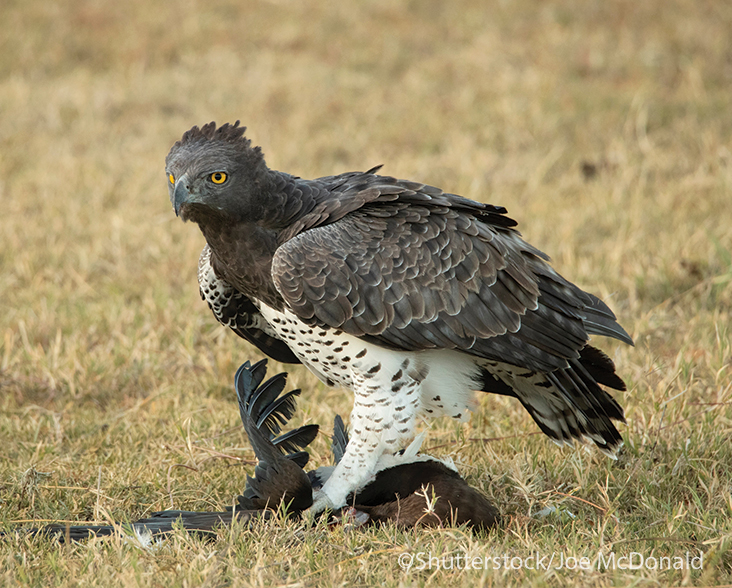Martial Eagle
Species Data
Class: Aves
Order: Accipitriformes
Family: Accipitridae
Scientific Name: Polemaetus bellicosus
IUCN Red List status:Endangered
Description
With a wingspan of over two metres and measuring 78-86 cm in length, the Martial Eagle is Africa’s largest eagle. They have a large head, stout bill, short crest, and long broad but pointed wings. Adults are brown-grey above with pale edges to the mantle, scapulars, tertials and especially the wing coverts, with a plain browner head and chest. The underparts are white and sparsely spotted dark brown on the belly, flanks and long feathered trousers. The relatively short white tail is thinly barred brownish-black. In flight, adults have dark brown underwing coverts contrasting with the brown and white barred flight feathers. Eyes are yellow and the cere and feet are pale greenish.
The sexes are similar, although females are usually more heavily spotted on the underparts, and average 10% larger than males. Juveniles are paler brown-grey above with broad whitish feather edges and speckled grey crown and hindneck, plain white below, and in flight show brown mottled white underwing coverts. The eyes are brown.
Behaviour
Largely solitary or in pairs, adult Martial Eagles are generally sedentary within their 125-150 km2 home range. This species is highly aerial, typically hunting on the wing, soaring, sometimes hovering, and diving from a height to capture vertebrate prey on the ground. Prey includes reptiles, mammals such as squirrels, hares, hyraxes, mongooses, small antelopes, Black-backed Jackal and cats such as Serval and Caracal, birds ranging from young Ostriches, Egyptian Geese and Helmeted Guineafowl, to Spotted Eagle Owl and Kori Bustard, and occasionally chickens.
Generally silent, even during breeding season. Nesting occurs during the dry season: November in west Africa, August-January in north-east Africa, February-November in east, central and south Africa. The large nest of sticks, 1.2-1.5 m wide and 60 cm deep, increasing with consecutive use to 2 m wide and deep, lined green leaves and situated in a large fork of an isolated tall tree or on a cliff or pylon. The single egg hatches after an incubation of 47-43 days, with fledging occurring 96-104 days later. Young remain with the adults for 8-12 months before dispersing, meaning adults breed every two years.


Habitat
The Martial Eagle is scarce to rare but widely distributed across much of sub-Saharan Africa, ranging from Senegal and the Gambia in the west, east to Ethiopia, and southwards through most of East Africa to South Africa.
This is a bird of open woodland, woodland edges, savannah, grassland, thornbush and desert, from sea level up to 1,500m, sometimes up to 3,000m.
Threats and Conservation
Although estimated as probably in the tens of thousands in 2001, the current global population is unknown. Observations reveal that this species has declined rapidly across much of its range since 1987, especially in unprotected areas, and continues to decline. Therefore, the Martial Eagle is categorised as Endangered on the IUCN Red List.
Shooting, trapping and poisoning by both commercial and tribal farmers, sometimes in retaliation for domestic livestock predation, are the biggest threats to this species. A decrease in natural prey may lead to increasing predation in future. Many protected areas are too small to support a breeding pair, forcing birds to forage further afield and making them more vulnerable to persecution. Other threats include habitat loss, electrocution on power lines, drowning in reservoirs, and hunting for use in traditional medicine.
